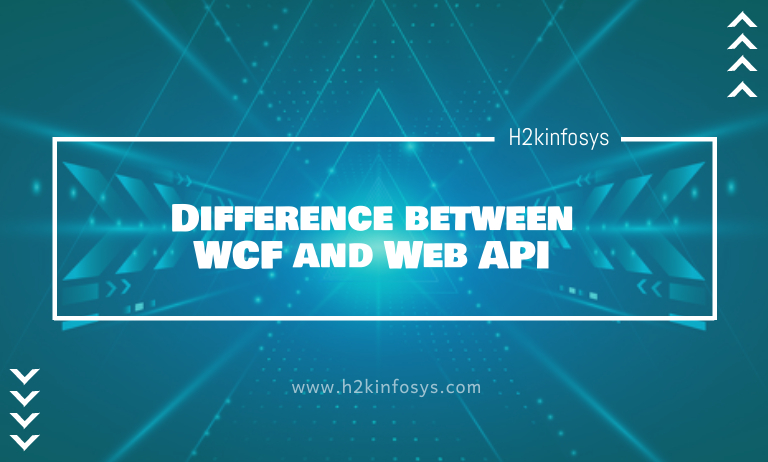Introduction
Modern applications need fast, secure, and scalable communication between systems. Developers must choose the right service framework to meet these needs. In the Microsoft dot net ecosystem, two popular technologies stand out. They are WCF and Web API. Understanding how WCF and Web API differ helps developers build better enterprise and cloud applications.
This guide explains the difference between WCF and Web API in clear terms. It uses real-world examples, simple code, and practical guidance. If you are preparing for asp dot net, dotnet online, or Asp.net certification, this topic is essential for interviews and projects.
What Is WCF?
Windows Communication Foundation (WCF) is a framework used to build service-oriented applications. Microsoft introduced WCF to support distributed systems. WCF allows applications to communicate using multiple protocols and message formats.
Key Characteristics of WCF
- WCF supports SOAP-based messaging
- WCF supports multiple transport protocols
- WCF supports advanced security models
- WCF supports reliable messaging and transactions
WCF works well in enterprise systems that require strict contracts and complex workflows. Many banking and healthcare systems still use WCF due to its strong security and transaction support.
Common Use Cases for WCF
- Enterprise service buses
- Banking transaction systems
- Internal corporate applications
- Legacy system integration
In these cases, developers often prefer WCF and Web API comparisons to decide what fits best.
What Is ASP.NET Web API?
ASP.NET Web API is a framework for building HTTP-based services. It focuses on RESTful architecture. Web API is lightweight, simple, and ideal for modern web and mobile apps.
Key Characteristics of Web API
- Web API follows REST principles
- Web API uses HTTP verbs like GET and POST
- Web API returns JSON or XML
- Web API integrates easily with front-end apps
Web API works well for cloud-native applications. Many developers choose Web API for microservices and mobile backends instead of WCF and Web API together.
Common Use Cases for Web API
- Mobile applications
- Single Page Applications
- Cloud microservices
- Public APIs
Core Architectural Difference Between WCF and Web API
The biggest difference lies in architecture. WCF and Web API solve similar problems but use different approaches.
| Aspect | WCF | Web API |
|---|---|---|
| Architecture | SOAP-based | REST-based |
| Protocols | HTTP, TCP, MSMQ | HTTP only |
| Message Format | XML | JSON/XML |
| Complexity | High | Low |
| Scalability | Moderate | High |
Developers who understand WCF and Web API architecture make better design choices in real projects.
Communication Protocol Support
WCF supports many transport protocols. This flexibility helps in closed enterprise networks. Web API focuses only on HTTP. This focus improves simplicity and scalability.
WCF Protocols
- HTTP
- TCP
- Named Pipes
- MSMQ
Web API Protocol
- HTTP only
When comparing WCF and Web API, protocol flexibility often guides the decision.
Data Format and Serialization
WCF primarily uses XML. Web API prefers JSON. JSON improves performance and reduces payload size.
Why JSON Matters
- Faster serialization
- Smaller payloads
- Better browser support
- Easier debugging
Modern developers favor JSON, which makes WCF and Web API very different in performance outcomes.
Hosting Options
WCF offers multiple hosting options. Web API also provides flexible hosting but in a simpler way.
WCF Hosting Options
- IIS
- Windows Service
- Self-hosted Console App
Web API Hosting Options
- IIS
- Self-hosted using OWIN
- Cloud hosting platforms
When deploying microservices, teams often choose Web API over WCF and Web API combined solutions.
Security Comparison
Security is critical in enterprise systems. WCF provides advanced built-in security. Web API relies on HTTP security standards.
WCF Security Features
- Message-level security
- Transport-level security
- WS-Security
- Reliable sessions
Web API Security Features
- HTTPS
- OAuth
- JWT tokens
- API keys
Both frameworks are secure, but WCF and Web API differ in configuration complexity.
Performance and Scalability
Performance depends on message size and processing overhead. Web API performs better for lightweight services.
Performance Comparison
- WCF uses heavy XML messages
- Web API uses lightweight JSON
- Web API scales better in cloud environments
For high-traffic APIs, Web API outperforms WCF and Web API legacy services.
REST vs SOAP: Practical Impact
SOAP enforces strict contracts. REST offers flexibility. This difference impacts development speed and maintenance.
SOAP (WCF)
- Strict contracts
- Strong typing
- Complex configuration
REST (Web API)
- Flexible design
- Easy integration
- Faster development
Most modern applications avoid SOAP and prefer Web API instead of WCF and Web API hybrid systems.
Code Example: Simple WCF Service
[ServiceContract]
public interface IProductService
{
[OperationContract]
string GetProduct(int id);
}
This code shows a WCF service contract. It requires configuration files and bindings.
Code Example: Simple Web API Controller
public class ProductController : ApiController
{
public IHttpActionResult Get(int id)
{
return Ok("Product " + id);
}
}
This Web API example is simple and readable. This simplicity explains why developers choose Web API over WCF and Web API combinations.
Versioning Support
Web API handles versioning better. WCF versioning is complex and risky.
Web API Versioning Options
- URL versioning
- Query string versioning
- Header versioning
This flexibility makes WCF and Web API very different in long-term maintenance.
Tooling and Developer Experience
Web API integrates smoothly with modern tools. WCF requires more setup.
Web API Advantages
- Easy testing with Postman
- Smooth front-end integration
- Faster onboarding
Developer productivity is higher with Web API than with WCF and Web API legacy stacks.
Cloud and Microservices Readiness
Cloud-native design favors Web API. WCF struggles in container environments.
Why Web API Wins in Cloud
- Stateless services
- Easy containerization
- Better scaling
Most DevOps teams avoid WCF and Web API together in cloud projects.
Career Perspective for .NET Developers
Recruiters expect knowledge of Web API. WCF knowledge helps in legacy support roles.
Skills Employers Look For
- REST API design
- JSON handling
- Authentication mechanisms
- ASP.NET Core integration
Training that covers WCF and Web API helps developers handle both legacy and modern systems.
When Should You Use WCF?
Use WCF when:
- You need message-level security
- You require transaction support
- You work with legacy systems
These scenarios still justify WCF and Web API knowledge.
When Should You Use Web API?
Use Web API when:
- You build REST services
- You target web or mobile apps
- You design cloud services
Most new projects avoid WCF and Web API overlap and choose Web API.
Industry Adoption Trends
Industry surveys show REST adoption continues to rise. SOAP usage declines every year.
- Over 80% of public APIs use REST
- JSON is the dominant format
- Microservices rely on HTTP APIs
This data explains why WCF and Web API comparisons often favor Web API.
Learning Path for ASP.NET Developers
A strong learning path includes:
- ASP.NET fundamentals
- REST concepts
- Web API development
- Security and authentication
- Deployment and scaling
Understanding WCF and Web API prepares developers for interviews and real projects.
Key Differences at a Glance
- WCF focuses on enterprise messaging
- Web API focuses on REST services
- WCF uses SOAP
- Web API uses HTTP and JSON
- Web API supports modern architectures
These points summarize WCF and Web API differences clearly.
Key Takeaways
- WCF suits legacy enterprise systems
- Web API suits modern web and cloud apps
- Web API is simpler and faster
- WCF provides advanced security
- Developers should understand both
Mastering WCF and Web API improves long-term career flexibility.
Conclusion
If you want hands-on expertise in asp dot net, dotnet training, and real-world service development, structured learning makes a difference.
Enroll in H2KInfosys courses today to gain practical skills, certification readiness, and job-focused .NET experience.

























